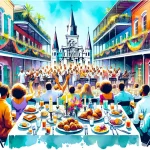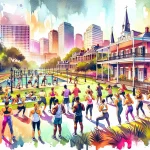New Orleans pulsates with the rhythm of music and dance, where the streets come alive with the infectious beat of brass bands and the energy of second-line parades. At the core of this cultural phenomenon lies a thriving dance club scene that has captivated locals and visitors for generations.
In This Article
TL;DR
- New Orleans offers a diverse and lively dance club scene catering to various musical preferences.
- Music and dance are deeply rooted in the local culture, reflecting the city’s rich heritage and artistic expression.
- Dance clubs enhance the nightlife experience by providing vibrant venues for socializing, dancing, and immersing in the city’s unique musical traditions.
Historical Context of Dance Clubs in New Orleans
The origins of New Orleans‘ dance club culture can be traced back to the early 20th century when jazz music emerged from the city’s melting pot of African, European, and Caribbean influences. As jazz clubs proliferated, they became gathering places for music enthusiasts and dancers, fostering a vibrant social scene celebrating movement and rhythm.
Over time, these traditional jazz clubs evolved into contemporary dance venues, embracing a wider range of musical genres while paying homage to the city’s musical heritage. The annual influx of visitors during major cultural festivals like Mardi Gras and the New Orleans Jazz & Heritage Festival further fueled the demand for lively dance clubs, solidifying their place in the city’s nightlife landscape.
Top Dance Clubs in New Orleans: Current Favorites
The Metropolitan Nightclub
This two-story club in the Warehouse District is a mecca for electronic dance music enthusiasts. With state-of-the-art sound systems, mesmerizing light shows, and a rotating roster of renowned DJs, The Metropolitan Nightclub has earned a reputation as one of the premier dance destinations in the city.
Republic New Orleans
Housed in a converted warehouse, Republic New Orleans is a sprawling nightclub that seamlessly blends industrial chic with cutting-edge technology. From its massive dance floor to its multiple bars and VIP areas, this club offers an unforgettable experience for those seeking a high-energy atmosphere and top-notch entertainment.
The Maison
Situated in the French Quarter, The Maison is a sophisticated and stylish dance club exuding an air of exclusivity. With its opulent decor, curated music selection, and strict dress code, this venue caters to a discerning crowd seeking a luxurious and upscale nightlife experience.
Music and Atmosphere: What to Expect
The music genres represented in New Orleans’ dance clubs are as diverse as the city itself. From the pulsating beats of hip-hop and electronic dance music to the sultry rhythms of Latin and Caribbean tunes, there is something to satisfy every musical palate.
The atmosphere within these clubs varies greatly, ranging from casual and laid-back to upscale and glamorous. Some venues embrace a specific theme or aesthetic, transporting patrons to different eras or cultural settings, while others opt for a more minimalist and contemporary vibe.
Regardless of the ambiance, one constant remains: the infectious energy that permeates the dance floors, fueled by the city’s love for music and movement.
Best Times to Visit Dance Clubs in New Orleans
While dance clubs operate throughout the week, certain days and times offer a more vibrant and lively experience. Weekends, particularly Friday and Saturday nights, are typically the busiest and most energetic, attracting a diverse crowd of locals and visitors.
Major events and festivals like Mardi Gras and the New Orleans Jazz & Heritage Festival also significantly impact the dance club scene. During these periods, clubs may extend hours, host special events, or feature guest DJs and performers, creating a heightened sense of excitement and celebration.
For a more intimate and relaxed atmosphere, weeknights can be an excellent option, offering a chance to experience the clubs without the crowds and at a more leisurely pace.
What Makes New Orleans Dance Clubs Unique?
New Orleans’ dance clubs stand apart due to their deep connection to the city’s rich cultural heritage. Many venues seamlessly integrate local traditions, music, and art into their overall experience, creating an authentic and immersive atmosphere celebrating the city’s unique identity.
From the incorporation of brass bands and second-line dancers to the fusion of Creole and Cajun influences in music and decor, these clubs offer a glimpse into the vibrant tapestry that makes New Orleans so captivating.
Additionally, the city’s renowned hospitality and laid-back attitude permeate the dance club scene, fostering a welcoming and inclusive environment where visitors can truly embrace the spirit of New Orleans.
Practical Tips for Club-goers
To ensure a seamless and enjoyable experience, it’s essential to be prepared. Many venues enforce dress codes, ranging from casual to upscale, so checking their policies beforehand is advisable. Entry fees may also apply, particularly on weekends or during special events.
Safety should be a top priority, and it’s recommended to travel in groups, utilize rideshare services or public transportation, and be mindful of your surroundings. Additionally, researching accommodation options near popular club districts can make for a more convenient and enjoyable night out.
Engaging with locals and participating in dance events like second-line parades or dance workshops can further enhance your experience and provide a deeper appreciation for the city’s vibrant dance culture.
Engaging with the Community: Clubs with a Cause
While many dance clubs focus on entertainment, some venues have taken a more socially conscious approach by engaging with the local community and supporting various causes.
Clubs like The Howlin’ Wolf have hosted benefit events and fundraisers for organizations dedicated to preserving the city’s cultural heritage and supporting local artists. By patronizing these establishments, visitors can contribute to the city’s cultural preservation efforts while enjoying a night of music and dancing.
Other clubs, such as The Maple Leaf Bar, have become hubs for community gatherings and activism, hosting events that raise awareness about social and environmental issues affecting the city and its residents.
Future of Dance Clubs in New Orleans
As New Orleans continues to evolve, so too does its dance club scene. Emerging trends, such as the integration of immersive technologies and interactive experiences, are reshaping how patrons engage with music and dance.
Clubs are embracing innovative approaches to attract new generations of party-goers while honoring the city’s rich musical traditions. From virtual reality dance floors to augmented reality performances, the future promises an exciting fusion of cutting-edge technology and cultural authenticity.
Moreover, the city’s resilience in the face of adversity, including natural disasters and the COVID-19 pandemic, has strengthened the resolve of its nightlife community. As New Orleans continues to rebuild and revitalize, its dance clubs will undoubtedly play a pivotal role in fostering a sense of community, celebration, and resilience.






